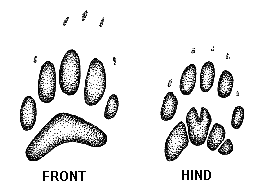
Badger
Taxidea taxus
Description
- This stout, shaggy animal is the largest of the
weasel family with only the wolverine exceeding it's size.
Its coat is a grizzled grey to brown with a white stripe
from upturned snout to shoulder. The tail is short, bushy
and yellowish; the cheeks white with dark patches; the
ears small and the feet dark with large foreclaws. The
male is larger than the female weighing usually 7-25 pounds.
Distribution
- The badger prefers open plains, farmlands and the edges
of woods. They range throughout southeast British Columbia
and a studfy in 1990 concluded that only 300-1000 badgers
likely occurred.
Biology
- 2-5 blind young are born in March or April. They feed
on squirrels, pocket gophers, rats and mice which they
usually capture by digging out their burrows. They also
eat birds, invertebrates, and carrion and are fond of
rattlesnake; they are apparently unharmed by the venom
unless the snake strikes its nose. A very ferocious animal,
the badger has few enemies. Its hair is used to make the
best quality paintbrushes, and the coarse bristles were
formerly used in shaving brushes. Forest succession and
encroachment into grasslands is reducing the habitat of
the badger, an animal vital in controlling rodent populations.

Tracks - These pigeon-toed creatures have powerful
feet and long claws on the front paws which are prominent
in most prints. The foot is made up of a series of small
pads. During the winter the body of the badger drags on
the snow leaving a trough of sorts.
Straddle: 10 - 18 cm (4 - 7 in)
Stride: 15 - 30 cm (6 - 12 in)
Track: Front - 6 cm (2.4 in) long / 5 cm (2 in) wide
Track: Rear - 5 cm (2 in) long / 5 cm (2 in) wide
|


